Abstract
The nature of lymphocyte subsets activated by soluble and insoluble protein A (SpA) was investigated by testing the ability of human tonsil populations to form rosettes with human red blood cells coated with SpA (SpA-HRBC) and to respond in vitro to SpA, SpA coupled to Sepharose beads (SpA-Seph) and Staphylococcus aureus strain Cowan I (StaCw).
Purified human T cells, which were unable to form rosettes with SpA-HRBC, were not activated by SpA-Seph or StaCw, whereas B-cell enriched suspensions, where the number of lymphocytes forming rosettes with SpA-HRBC was significantly increased in comparison with that found in unfractionated populations, showed DNA synthesis equal to or greater than unseparated lymphocytes. In contrast, soluble SpA was unable to activate highly purified B lymphocytes in 3 day cultures and induced higher DNA synthesis in unseparated than in purified human T cells. Tonsil cell suspensions depleted in cells forming rosettes with SpA-HRBC synthesized significantly less DNA in the presence of SpA-Seph and lost the ability to respond to StaCw. The depletion in either IgG-bearing or IgM- and/or IgD-bearing cells induced a reduction in the response of lymphocytes to SpA-Seph and StaCw. Depletion in IgM- and/or IgD-bearing cells induced a more marked decrease in the response to StaCw than depletion in IgG-bearing lymphocytes, while the decrease of the response to SpA-Seph, induced by depletion in IgM- and/or IgD-bearing cells, was lower than that induced by depletion in IgG-bearing lymphocytes. In contrast, soluble SpA-induced proliferation was not significantly affected by depletion of cells forming rosettes with SpA-HRBC or of IgG-bearing or IgM- and/or IgD-bearing lymphocytes. These results suggest that the mitogenicity of SpA-Seph and StaCw is due to a selective binding of insoluble SpA to components present on the membrane of either IgG-bearing or IgM- and/or IgD-bearing lymphocytes. They also indicate that the potentiation of T-cell response to soluble SpA, induced by the presence in culture of non-T cells, is not due to B lymphocytes which are able to form rosettes with SpA-HRBC and to respond to SpA itself when it is presented to the cells on an insoluble matrix.
Full text
PDF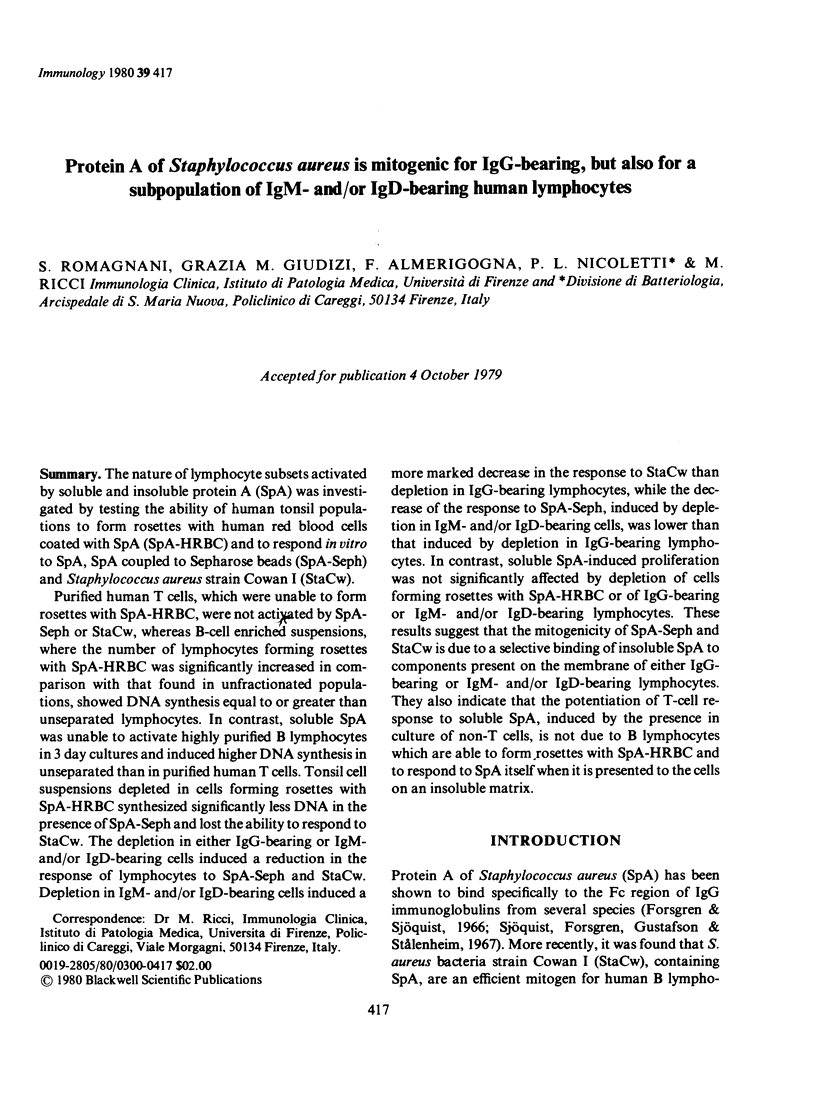
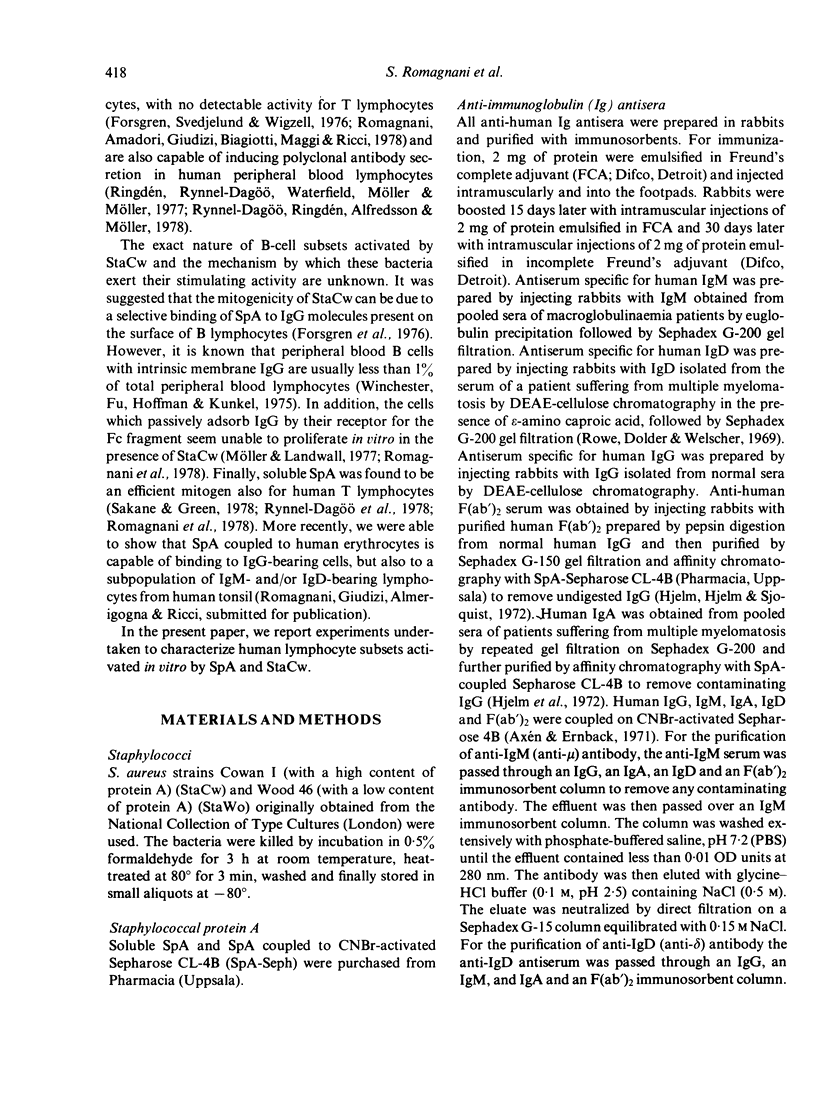
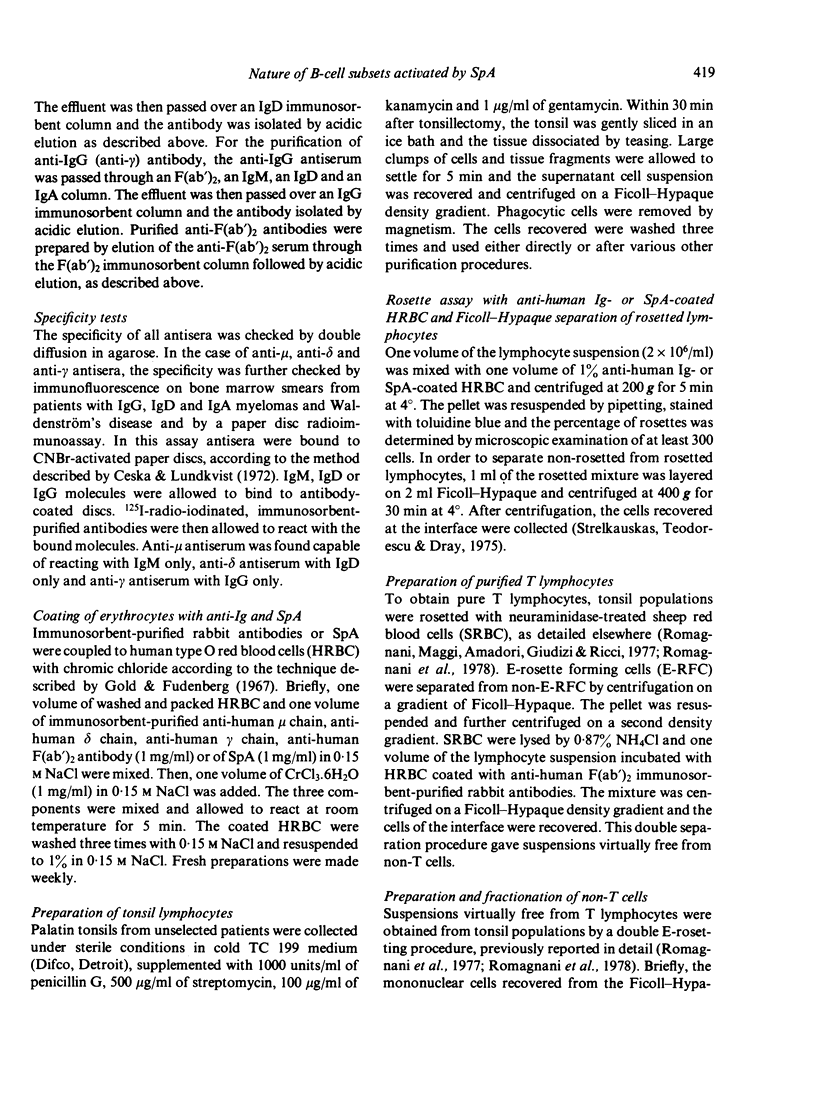
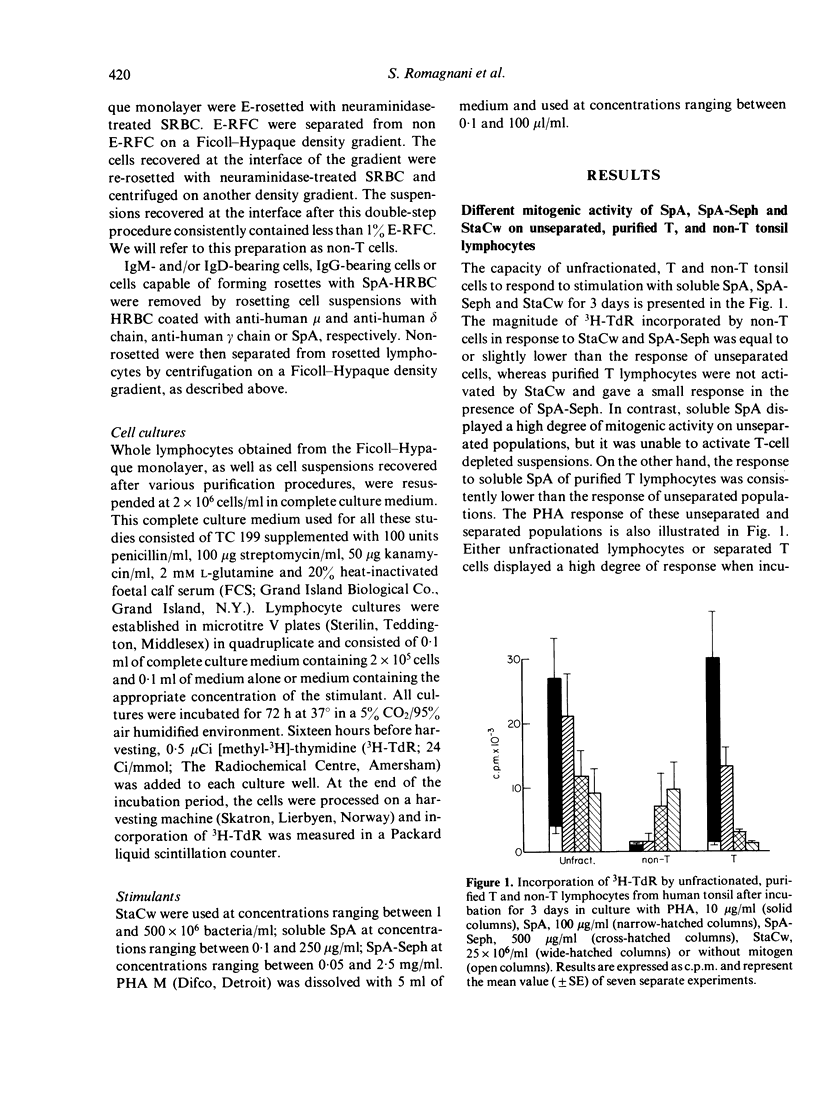
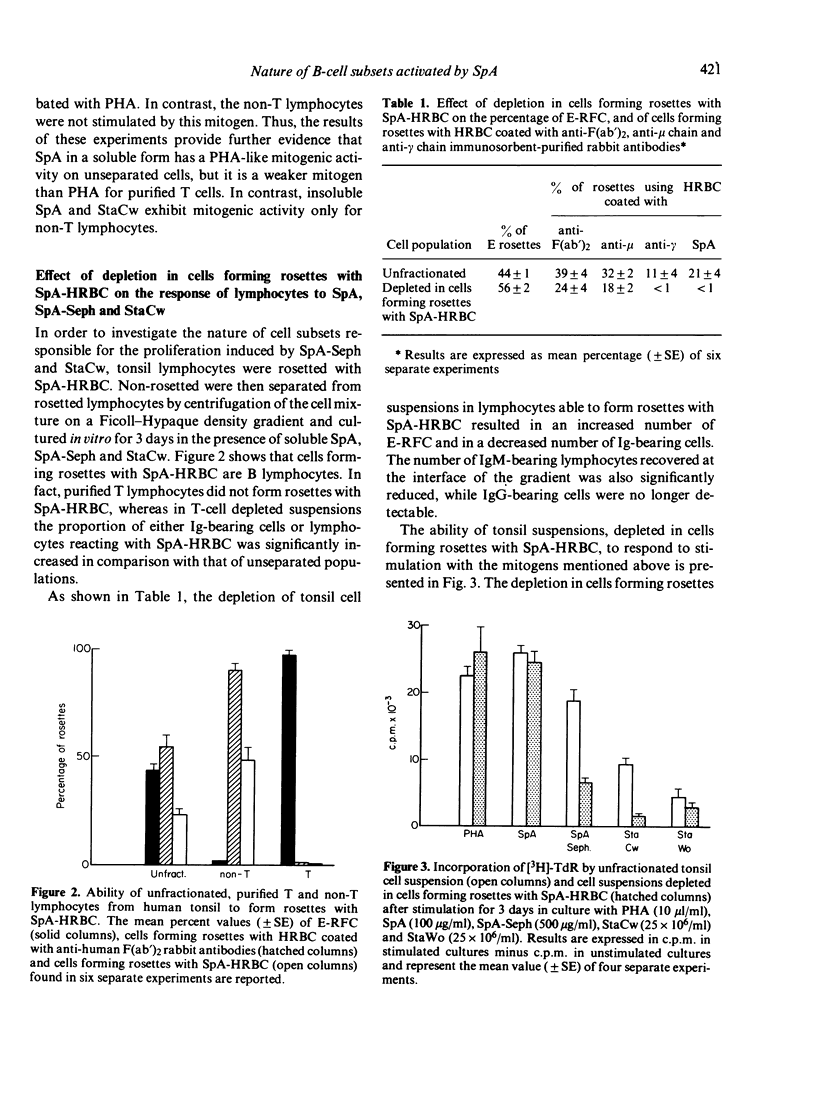

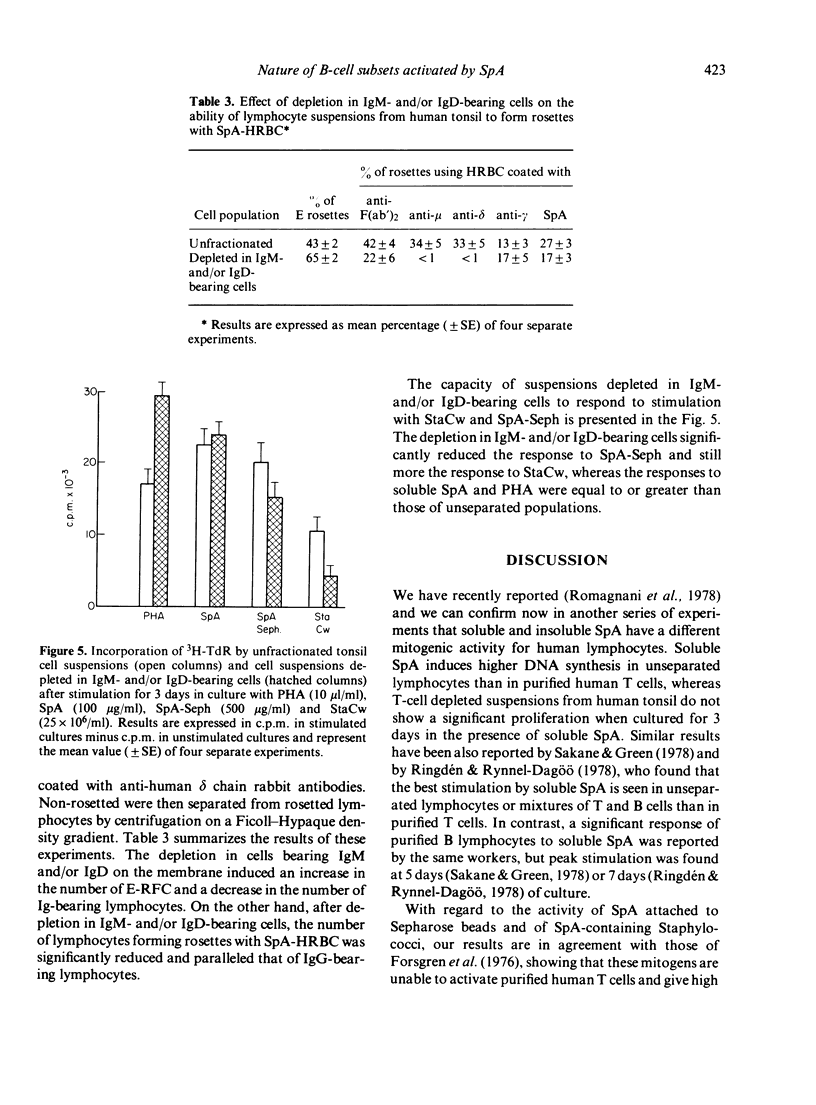

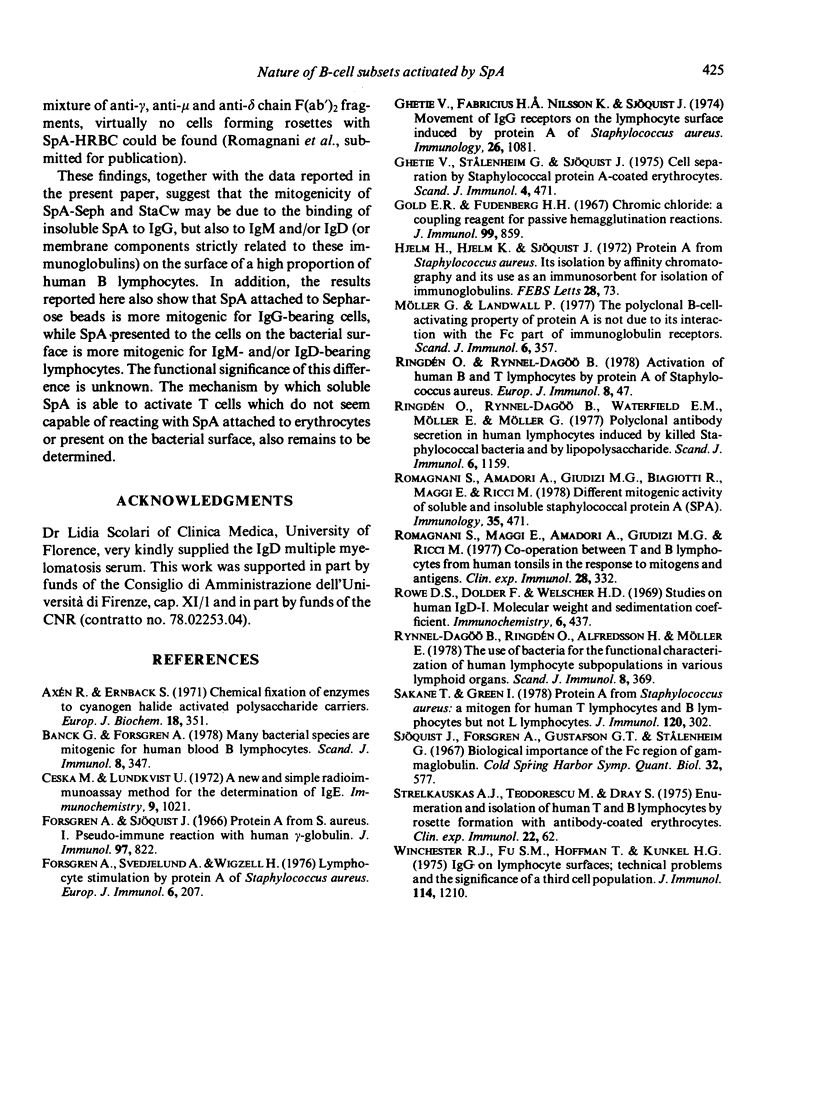
Selected References
These references are in PubMed. This may not be the complete list of references from this article.
- Axén R., Ernback S. Chemical fixation of enzymes to cyanogen halide activated polysaccharide carriers. Eur J Biochem. 1971 Feb 1;18(3):351–360. doi: 10.1111/j.1432-1033.1971.tb01250.x. [DOI] [PubMed] [Google Scholar]
- Banck G., Forsgren A. Many bacterial species are mitogenic for human blood B lymphocytes. Scand J Immunol. 1978;8(4):347–354. doi: 10.1111/j.1365-3083.1978.tb00528.x. [DOI] [PubMed] [Google Scholar]
- Forsgren A., Sjöquist J. "Protein A" from S. aureus. I. Pseudo-immune reaction with human gamma-globulin. J Immunol. 1966 Dec;97(6):822–827. [PubMed] [Google Scholar]
- Forsgren A., Svedjelund A., Wigzell H. Lymphocyte stimulation by protein A of Staphylococcus aureus. Eur J Immunol. 1976 Mar;6(3):207–213. doi: 10.1002/eji.1830060312. [DOI] [PubMed] [Google Scholar]
- Ghetie V., Stålenheim G., Sjöquist J. Cell separation by staphylococcal protein A-coated erythrocytes. Scand J Immunol. 1975 Sep;4(5-6):471–477. doi: 10.1111/j.1365-3083.1975.tb02652.x. [DOI] [PubMed] [Google Scholar]
- Gold E. R., Fudenberg H. H. Chromic chloride: a coupling reagent for passive hemagglutination reactions. J Immunol. 1967 Nov;99(5):859–866. [PubMed] [Google Scholar]
- Möller G., Landwall P. The polyclonal B-cell-activating property of protein A is not due to its interaction with the FC part of immunoglobulin receptors. Scand J Immunol. 1977;6(4):357–366. doi: 10.1111/j.1365-3083.1977.tb00405.x. [DOI] [PubMed] [Google Scholar]
- Ringdén O., Rynnel-Dagö B., Waterfield E. M., Möller E., Möller G. Polyclonal antibody secretion in human lymphocytes induced by killed staphylococcal bacteria and by lipopolysaccharide. Scand J Immunol. 1977;6(11):1159–1169. doi: 10.1111/j.1365-3083.1977.tb00355.x. [DOI] [PubMed] [Google Scholar]
- Romagnani S., Amadori A., Giudizi M. G., Biagiotti R., Maggi E., Ricci M. Different mitogenic activity of soluble and insoluble staphylococcal protein A (SPA). Immunology. 1978 Sep;35(3):471–478. [PMC free article] [PubMed] [Google Scholar]
- Romagnani S., Maggi E., Amadori A., Giudizi M. G., Ricci M. Co-operation between T and B lymphocytes from human tonsils in the response to mitogens and antigens. Clin Exp Immunol. 1977 May;28(2):332–340. [PMC free article] [PubMed] [Google Scholar]
- Rowe D. S., Dolder F., Welscher H. D. Studies on human IgD. I. Molecular weight and sedimentation coefficient. Immunochemistry. 1969 May;6(3):437–443. doi: 10.1016/0019-2791(69)90299-7. [DOI] [PubMed] [Google Scholar]
- Rynnel-Dagö B., Ringdén O., Alfredsson H., Möller E. The use of bacteria for the functional characterization of human lymphocyte subpopulations in various lymphoid organs. Scand J Immunol. 1978;8(5):369–375. doi: 10.1111/j.1365-3083.1978.tb00531.x. [DOI] [PubMed] [Google Scholar]
- Sakane T., Green I. Protein A from Staphylococcus aureus-a mitogen for human T lymphocytes and B lymphocytes but not L lymphocytes. J Immunol. 1978 Jan;120(1):302–311. [PubMed] [Google Scholar]
- Strelkauskas A. J., Teodorescu M., Dray S. Enumeration and isolation of human T and B lymphocytes by rosette formation with antibody-coated erythrocytes. Clin Exp Immunol. 1975 Oct;22(1):62–71. [PMC free article] [PubMed] [Google Scholar]
- Winchester R. J., Fu S. M., Hoffman T., Kunkel H. G. IgG on lymphocyte surfaces; technical problems and the significance of a third cell population. J Immunol. 1975 Apr;114(4):1210–1212. [PubMed] [Google Scholar]


